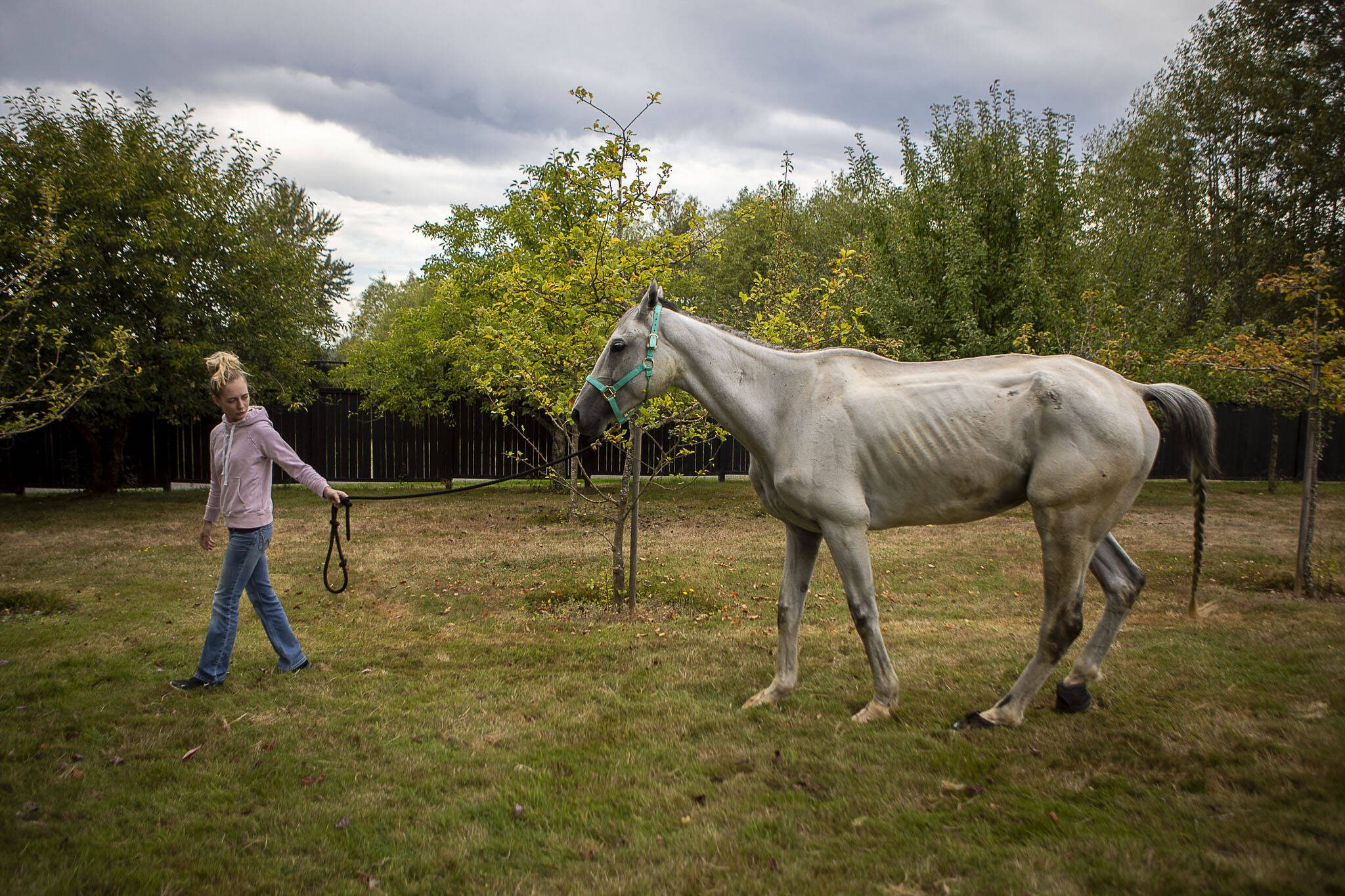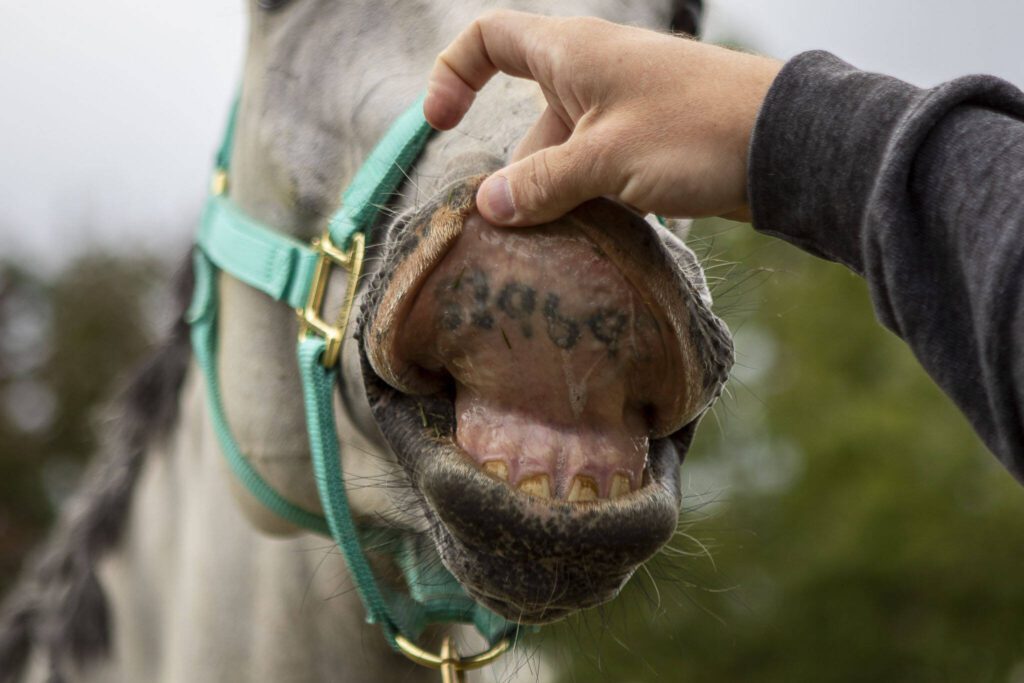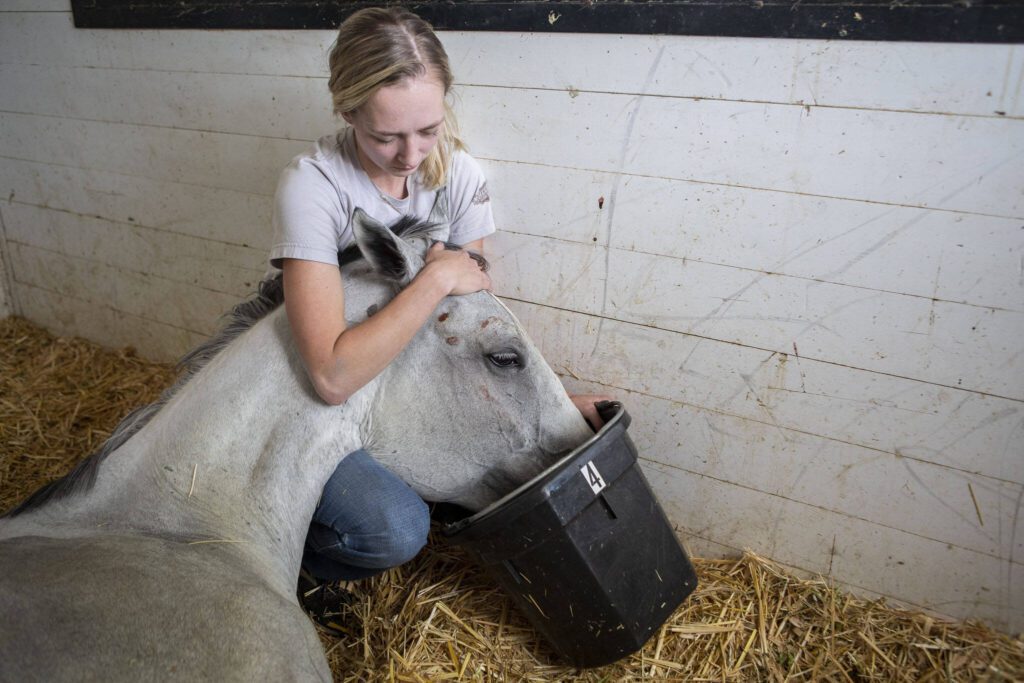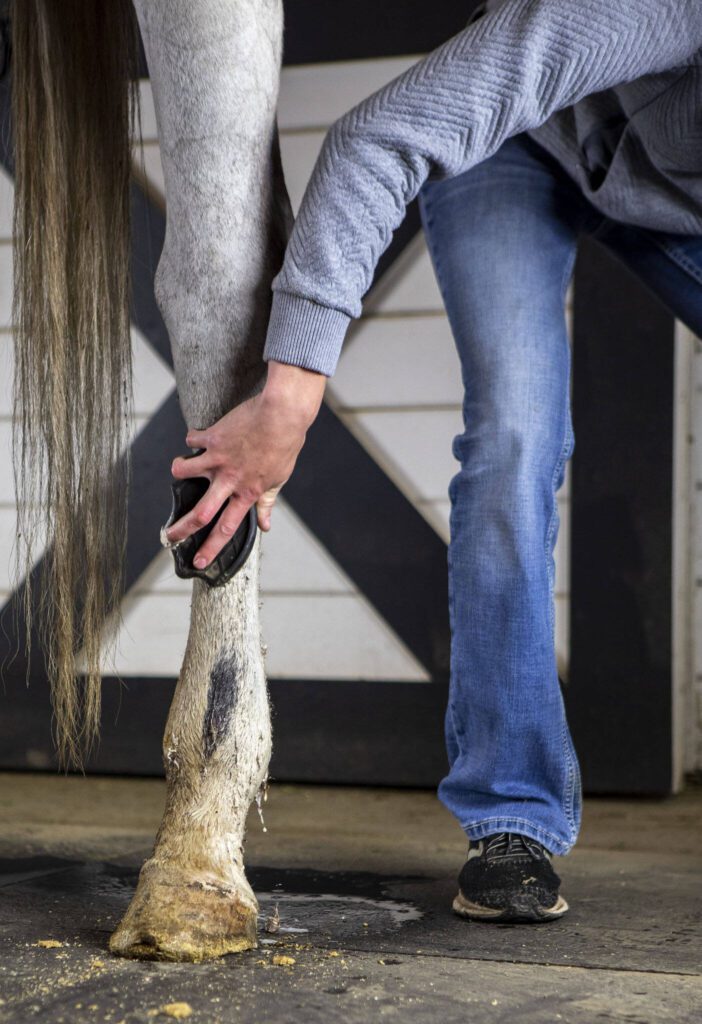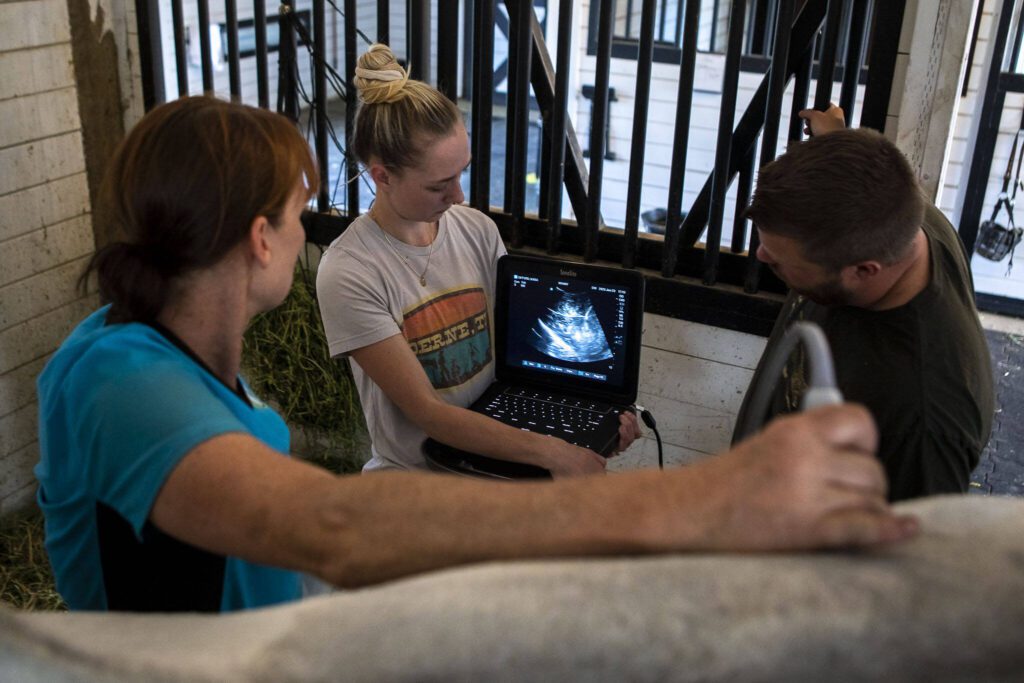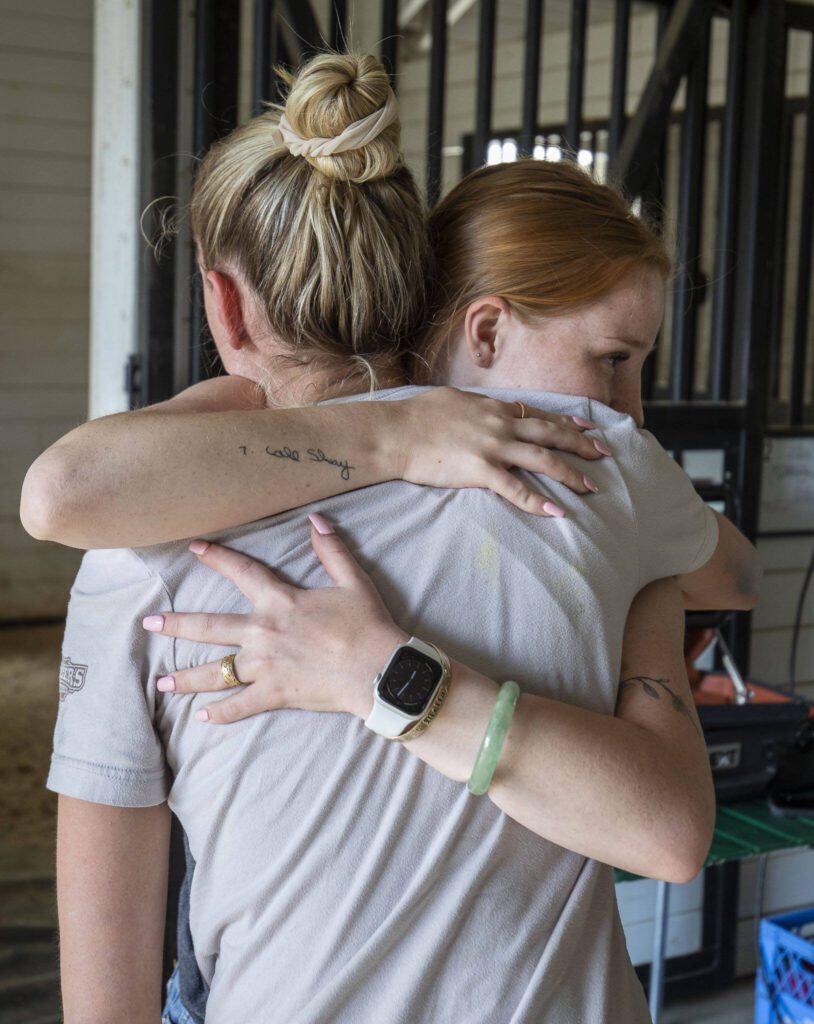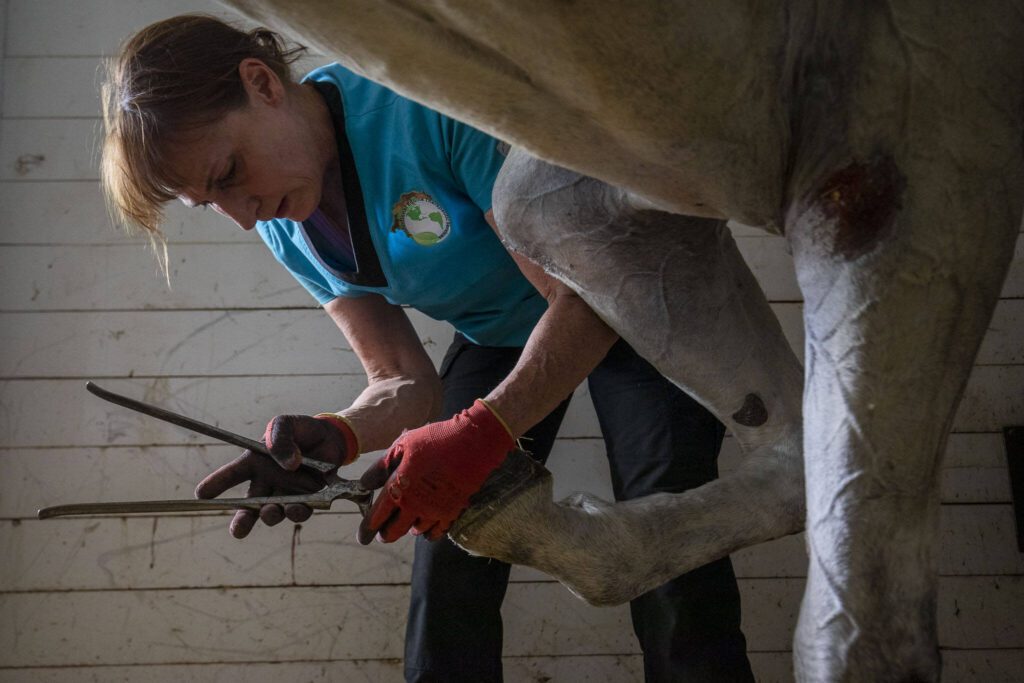SNOHOMISH — Pioneer Man’s luck ran out after seven years.
In his heyday, the big chestnut horse brought home $114,000 in prize money.
By age 7, his years at the track had taken their toll.
After a short, four-year racing career, Pioneer Man was no longer a good bet. His knees were chipped. He could no longer earn his keep.
Worn out, used up, the thoroughbred was sold to a kill pen in Texas, a way station for horses awaiting transport to slaughterhouses in Canada or Mexico.
Kaisa Gifford spotted Pioneer Man on an online auction site for slaughter-bound horses.
The Snohomish resident paid $1,650 for the gelding, a bargain considering he’d sold for $350,000 as a colt.
“I actually had him unloaded from a truck as he was getting tagged to go to Mexico,” Gifford said of the horse’s arrival in fall 2022.
At a neatly trimmed white barn east of Snohomish, Gifford offers former racehorses, known for their speed, agility and high spirits, a second chance.
Since 2021, Gifford Horses has rescued and rehomed more than 50 thoroughbreds, many destined for slaughter, she said.
She bandages their wounds, re-trains them and sells them to caring owners. Their sale helps pay for hay and the next horse.
They will find new purpose and second careers as trail horses, show jumpers or someone’s cherished pasture pet, she said.
“The idea is to put value back in the horse so they never end up back in a bad situation,” Gifford said. “They’re worth something to someone.”
Gifford, a mortgage loan manager by day, usually has 18 to 20 horses in her care at two barns in Snohomish or quarantined at a friend’s barn in Texas.
Family and supporters help finance the effort. Gifford’s Facebook, TikTok and Instagram accounts pull in donations. She recently applied for nonprofit status.
“It’s a full-time operation out here, morning and nights,” said Bob Cumming, who owns one of the barns. “Kaisa and the rest of her team are in and out of here cleaning and taking care of the horses. It’s nonstop.”
‘Heart and soul’
Gifford, 26, has spent nights nursing sick horses, sleeping on a blanket in the stall, praying they won’t die in the middle of the night.
“These are big, 1,200-pound animals. People think they’re indestructible, but they’re incredibly delicate,” said Ashley Winterroth, a Lake Stevens equestrian who has known Gifford for four years.
“Kaisa takes on the hard cases,” Winterroth added. “She puts her heart and soul into these animals.”
Gifford’s love for horses began as a teenager. Begging her mother for riding lessons, she promised to earn good grades in school.
A bargain was struck, and a passion born.
But until her early 20s, Gifford had never owned a horse.
When her husband, Charles, was a soldier stationed in Texas, she met “a wonderful woman who gifted me her thoroughbred horses,” she recalled.
Now, her work is her way of “giving back to the horses,” Gifford said.
“There have been so many times in my life when I’ve had nothing, but I always had my horse,” she said. “They’ve given so much to me.”
Thoroughbreds make good trail and riding horses, because “they have so much heart and willingness, ” she said.
The notion that thoroughbreds are untrainable and high-strung isn’t true, she said.
“A lot of people say you’re going to get something wild and crazy out of the kill pen,” she said.
Sometimes, temper is a sign an animal hasn’t been properly cared for. One of the first thoroughbreds Gifford took in, Tdz What a Dream, was deemed “crazy.”
As it turned out, his teeth hadn’t been ground down, she said. The sharp points were cutting into his mouth, causing ulcers.
Domestic horses need their teeth filed once a year. A veterinarian is called and power tools do the trick, she explained.
Now, he’s taking 8-year-old kids trail riding on Vashon Island, Gifford said.
Thoroughbreds are people pleasers, Gifford said: “They’re like golden retrievers. They’ll give you everything they have.”
‘We could only save one’
Horse racing is a big money sport.
In 2021, Americans bet over $12 billion on the ponies, according to Equibase, the North American racing database.
Each year, about 20,000 thoroughbred foals in the United States and Canada are registered with the Jockey Club, the North American thoroughbred breed registry.
Only a fraction will find success at the starting gate. And even if they do, it’s a short course. The average thoroughbred will compete just two or three years, despite a life expectancy of 20 years or more.
What happens after their career ends depends on owners, trainers and racetrack officials.
Keeping a horse at a racetrack stall can cost tens of thousands of dollars for the season, Gifford said.
“If they don’t make money, they’re out the door,” writer Vickery Eckhoff said in the 2016 documentary “From the Kill Pen.”
Some thoroughbreds will be brought to auction, along with ponies, show horses, trail horses and draft horses, according to The Humane Society of the United States.
If they’re lucky, they’re bid on by people looking for trail or riding horses.
If not, they may be purchased by kill-pen buyers, middlemen who buy horses at auction and sell them for slaughter.
The last U.S. horse meat processing plant closed in 2007.
The closure stemmed from Congress’ decision in 2006 to withdraw federal funding for horse meat inspection. Horse meat cannot be sold in the United States because it is not approved by the U.S. Department of Agriculture — more for cultural reasons than health. However, horses can be shipped to other countries for slaughter. Snohomish County formally banned the slaughter of horses for food in 2012.
Export numbers have fallen. In 2018, more than 70,000 horses were taken to Mexico or Canada for slaughter, according to the USDA. Last year, it was 25,000 U.S. horses.
For the horses, it’s a painful, harrowing journey.
Crammed into cattle trailers, without food or water, they kick and trample one another, the Humane Society and animal welfare groups say.
Horses are dispatched like cattle at some slaughterhouses, repeatedly shocked, then shot through the skull with a steel bolt.
The meat is then shipped to countries in Asia and Europe for human consumption. At least 85% of horses slaughtered at European Union–approved Canadian horse slaughterhouses come from the United States, according to the American Veterinary Medical Association.
For Gifford, even one horse sent to slaughter is too many. She and her husband recently visited a kill pen in Texas. There, they saw sick, thirsty animals taunted for no apparent reason, she said.
“They were running them around the pens and chucking rocks at him,”Gifford said. “I saw for the first time where these horses come from.
There was a single bucket of water for dozens of horses.
They rescued a quarter horse, and then watched 40 horses loaded onto a truck, bound for slaughter.
“We could only save one, but we wanted to save them all,” she said.
A bipartisan coalition in the U.S Senate and House recently introduced the Save America’s Forgotten Equines Act, which would permanently ban the slaughter of horses for human consumption and the export of horses for slaughter.
The bill was referred to a subcommittee, where it remained this week.
In the meantime, animal advocates say the more humane solution is euthanasia, not slaughter.
“A horse who can no longer live comfortably due to age or illness should be humanely euthanized rather than suffer the hardships of auctions and a trip to the slaughter plant,” the Humane Society argues.
Gifford agrees.
“If you can’t care for your horse and you can’t find someone to take care of it, euthanize it,” Gifford said. “If it has a fractured knee and you can’t afford the surgery, euthanize it.
She added: “It may sound brutal, but the alternative, the trauma of the kill pens, is much worse.”
‘All very murky’
American racetracks ban horse slaughter, but in some parts of the country, enforcement is lax.
Most of Gifford’s thoroughbreds are rescues from Southern states.
“Pioneer Man came from Louisiana, notoriously one of the worst states for animal rights,” Gifford said. “The Western states are better. There are more eyes on them, here. Down south, it’s just kind of free for all.”
Still, it can happen anywhere, said Nancy Perry, senior vice president of government relations for the American Society for the Prevention of Cruelty to Animals, based in New York City. Perry has followed the issue since 2004.
Unable to afford or care for a horse, an owner may bring it to the local auction, hoping it will find a new home.
But that doesn’t always happen.
“You have these kill pen buyers show up and they’re standing right next to legitimate horse buyers,” Perry said. “It’s all very murky.”
Well-funded kill buyers often outbid local horse fanciers, she said.
“Some of these horses show up for the slaughter house with braids still in their hair,” Perry said.
Perry said her organization is working to get federal legislation banning horse slaughter “once and for all.”
“It’s still too easy to transport horses from state to state,” she said.
Washington state has strict rules regarding the humane treatment of livestock and horses, said Amanda Benton, deputy secretary of the Washington Horse Racing Commission. The agency regulates horse racing in the state and works closely with the industry to ensure the animals “are well taken care of,” Benton said.
Trainers who want their horses to compete at Emerald Downs in Auburn must apply for stalls at the track.
“One of the house rules is they cannot knowingly sell a horse to slaughter,” Benton said.
Jack Hodge, vice president of Emerald Downs Racing, said if officials “get word a horse is in a predicament and is in danger of possibly going to slaughter, we would step in to help.”
“If it’s determined a trainer or owner sends a horse to slaughter, they lose their privilege to race at Emerald Downs,” Hodge said.
Emerald Downs also sponsors the Prodigious Fund, which supports the re-homing and care of retired racehorses. It is funded by donations from the track, trainers and owners.
“If a horse needs surgery or care to ready for them for a second career, the fund is there to assist,” Hodge said. “Everybody chips in to make sure these wonderful athletes go on to second careers.”
Other local groups offering race horses a second career include Second Chance Ranch in Spokane and Down the Stretch Ranch, about 50 miles west of Spokane.
A racing fan, Gifford enjoys rooting for the ponies at Emerald Downs.
“There are horses I’ve been watching for years,” she said.
Banning horse racing is not Gifford’s aim.
“As much as I see the dark side of racing, you have all the wonderful people — the ones who really do care,” she said.
It’s the fate of the kill pens that troubles her.
Gifford and other rescue groups say they hope to snatch as many thoroughbreds from kill pens as they can.
But in some circles, buying horses from a kill pen is controversial.
“Kill pens will post photos of horses at online sites with impending ship dates for slaughter,” said Perry, of the ASPCA.
The photos are paired with plaintive appeals urging rescuers to “save” them from the slaughterhouse by paying a “bail” price, Perry said.
“It’s just another way for kill pen buyers to profit,” she said.
Gifford knows the dilemma.
“At the slaughterhouse, they may only fetch $500, and you end up paying $1,000 or $2,000 for them,” Gifford said. “So you are putting money in their pocket.”
But her heart has the last word.
“It’s either you put money in someone’s pocket or the horse is going to go to slaughter,” Gifford said. “Yes, I’m paying someone. I don’t know how to change it. But I’m saving a horse.”
‘Alvin was dumped’
Patience is Gifford’s watchword.
Race horses are taught to go right, left and forward as fast as they can.
“We spend a lot of time teaching them to relax and slow down,” she said.
In six weeks or a year, however long it takes, they will leave here a new horse, she said.
Pioneer Man arrived emaciated and sick more than a year ago.
Inside the well-kept barn, lit by an electric chandelier, she gave him the first stall on the right.
Within a few weeks, his spirit and appetite were revived.
“If they keep standing up and keep eating, you know they’re going to make it,” she said.
At the sight of her, Pioneer Man stopped munching his hay, tossed his dark mane, curled his lips, showing a mouthful of teeth and a blue tattoo on his upper lip, a standard race horse identifier.
In the stall next to him, Goodrockinalvin, a dark bay, buried his nose in a feed bag.
“Alvin was dumped after racing,” Gifford said. “I bought him around the same time as Pioneer Man.”
Six-hundred pounds underweight and barely the will to live, “we thought he was going to pass in the middle of the night,” said Gifford, who keeps cameras pointed at the stalls. “He’s only 5 years old.”
By midsummer, Alvin had recovered, and Pioneer Man was on his way to his forever home in Colorado.
Chelsea Ramerman, in the market for a horse, bought Alvin and another one of Gifford’s thoroughbreds, Blood Red Moon, who had retired from Emerald Downs.
Seeking a trail riding horse for her husband and 12-year-old daughter, “they had to be safe. They had to be trained,” the Ellensburg resident said.
“People said, ‘I can’t believe you bought an off-track thoroughbred for your daughter,’ but Kaisa knows her horses,” Ramerman said. “I trust her. She trained them. She told me what they’d be and it’s all turned out to true.”
Red, now nicknamed Snickers, has an easy life and so does Alvin, Ramerman said.
“He gets the best hay. He sleeps on a mattress in his stall. He’s made friends with the cows next door,” she said.
“What she’s doing is pretty awesome,” she added. “We’re happy to have horses that definitely got a second chance.”
‘He’s a fighter’
Rifle Man, the color of an overcast sky, showed up, fittingly, at Gifford Horses on a cool rainy day in May.
His winnings at the track totaled $140,000, according to Equibase.
But by the time he got to Snohomish, an abscess on his left hind leg oozed pus and blood. His ribs and hip bones jutted against his smoky gray coat.
“He last raced four weeks ago,” said Gifford, kneeling on the stall floor and applying a compression bandage to his left hind leg.
Since then, he’d been up for auction three times, in Louisiana, Oklahoma and Texas, she said.
Gifford bought him for $1,000 and then the kill pen seller demanded another $1,000. She paid up.
She picked him up from the hauler in Oregon and drove him to the barn.
From the racetrack to the kill pen, Rifle Man — or as Gifford nicknamed him, Manny — had lost nearly a third of his weight.
His body was a welter of sores and gashes.
Appalled at his condition, Gifford called racing officials at Louisiana Downs and asked that his trainer be suspended.
She prevailed.
“The trainer that dumped him had a stop put on him,” Gifford said. “He can still haul horses to the racetrack, but he won’t be able to get stalls again at Louisiana Downs.”
Manny stood placidly while Gifford examined an infected hoof. Soulful brown eyes peered from a face covered in dark scars and scratches. It looked, she said, as if he had galloped headlong into a barbed wire fence.
Two weeks later, Manny was on death’s door. An infection coursed through his body. One of the veterinarians Gifford consulted advised her to euthanize him.
Gifford slept in the stall with him, keeping watch.
Friends pitched in.
“He has to be rotated every two hours,” Gifford said. “If they lay on one side too long they can paralyze the front leg they’re laying on. Their facial nerves can detach from being on the ground. It’s crazy stuff.”
Unable to stand or drink water, Gifford and her helpers would hold his head up so he could drink from a bucket. Many donated to his care.
It was touch and go for weeks.
“He’s a fighter. He’s tougher than wet leather,” Gifford said. “If this horse makes it through, I may not be able to give him up.”
By September, the big gray horse was gingerly ambling through a field next to the barn, wending his way through apple trees and fallen fruit. New shoes cradled his tender hooves.
Manny, back on his feet, has “zero limitations,” Gifford said. “We plan to keep him and jump him in a year. He’ll have the whole winter off.”
As September drew to a close, the barn was near empty.
“Time to fill up the stalls again,” she said.
Janice Podsada: 425-339-3097; jpodsada@heraldnet.com;
Talk to us
> Give us your news tips.
> Send us a letter to the editor.
> More Herald contact information.
